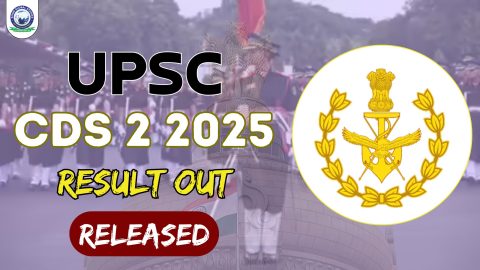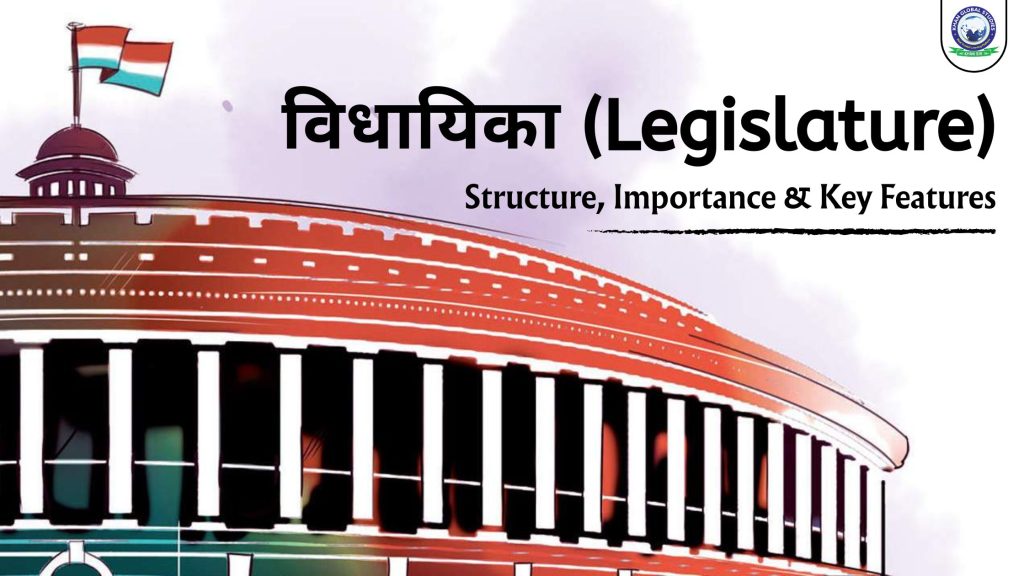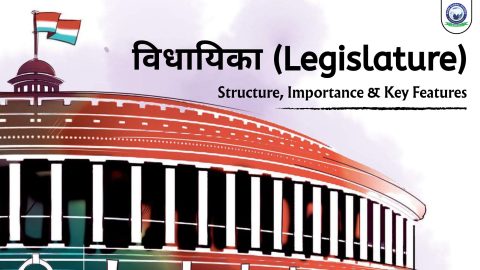The Legislature is the first and fundamental pillar of any democratic nation. Along with the executive and the judiciary, the Legislature forms the trinity of governance that ensures balance, order, and representation in the system. The Legislature acts as a bridge between the government and the people, makes laws, formulates policies, and ensures accountability.
Definition and Meaning of Legislature
The word Legislature is derived from two words – “legis” means law, and “lectus” means the body that acts. In simple terms, the Legislature is the law-making body of the government. It works within the constitutional framework and has the power to make, amend, or repeal laws to meet the changing needs of society.
Why is the Legislature Important in a Democracy?
The Legislature is the voice of the people, composed of elected representatives who act on behalf of the citizens. Its major roles include:
- Drafting new laws and amending existing laws
- Approving government expenditure through the budget
- Monitoring the executive to ensure transparency
- Representing public interests and raising community concerns
A strong legislature guarantees that the government remains accountable, democratic values are upheld, and policies are in line with the best interests of the public.
Structure of Legislature in India
1. Union Legislature: Indian Parliament
The Parliament of India is the supreme legislative body at the national level. It consists of:
- Lok Sabha (House of the People): This is the lower house, composed of representatives directly elected from various constituencies across the country. It represents the will of the common citizens.
- Rajya Sabha (Council of States): The upper house represents the states of the Indian Union. Its members are either elected by the state legislatures or nominated by the President for their expertise.
- President of India: Despite not being a part of the daily legislative functioning, the President is an integral part of the Parliament. No bill becomes a law without the President’s assent.
2. State Legislature
Each state in India has its legislative structure, which can be any of the following:
- Unicameral – consists of only the Vidhan Sabha (Legislative Assembly)
- Example: Punjab, Haryana, Gujarat
- Bicameral – consists of the Vidhan Sabha (Lower House) and the Vidhan Parishad (Legislative Council)
- Example: Uttar Pradesh, Maharashtra, Karnataka
The Vidhan Sabha is directly elected by the people. The Vidhan Parishad consists of members elected by the MLAs, graduates, teachers and nominated by the Governor.
Main Functions of the Legislature
1. Lawmaking
The Legislature’s primary responsibility is to make laws that govern the country or state. This includes:
- Introducing bills (proposals for new laws)
- Debating and voting on proposed legislation
- Amending or repealing existing laws
Both the Lok Sabha and Rajya Sabha must approve bills, after which they are sent to the President for approval.
2. Budget Approval
Each year, the government presents a financial budget detailing its income and proposed expenditures. The Legislature:
- Reviews and debates the budget
- Suggests amendments or allocations
- Allows the executive to spend public money
Without the Legislature’s consent, the government cannot use the national treasury.
3. Oversight of the Executive
The Legislature serves as a watchdog over the executive branch. Through:
- Question Hour
- Zero Hour
- No-Confidence Motion
- Standing Committees
Members of Parliament and Legislative Assemblies scrutinise the work of ministries, seek clarifications and hold the government accountable.
4. Voice of the People
Elected legislators raise the grievances, needs and aspirations of the public in the House. It:
- Apprise the government of the ground-level realities
- Helps in formulating inclusive policies
- Encourages debate on social justice, equality and reforms
5. Amendments to the Constitution
The Indian Constitution is a living document, which can be amended from time to time. The power to amend lies with the Legislature, which ensures:
- Flexibility and relevance of laws
- Alignment with current social values
- Protection of civil rights and democratic principles
Types of Legislature
1. Unicameral Legislature
In a unicameral system, there is only one legislative house. It is:
- Simple in structure
- Cost-effective
- Ensures faster lawmaking
States like Punjab, Kerala, Haryana, etc. operate under this system.
2. Bicameral Legislature
- A bicameral system consists of:
- A lower house (e.g., Lok Sabha or Vidhan Sabha).
- An upper house (e.g., Rajya Sabha or Vidhan Parishad).
- This structure:
- Encourages scrutiny of laws.
- Provides representation to diverse groups.
- Provides a check-and-balance mechanism.
- Although it may be slow, it supports comprehensive and thoughtful legislation.
Legislature vs Executive: What is the Difference?
| Aspects | Legislature | Executive |
| Funcations | Makes Laws | Implements Laws |
| Key Persons | MPs, MLAs | PM, CM, Ministers |
| Powers | Monitors Government | Administers Governance |
| Nature | Representative Body | Administrative Body |
Distinctive Features of the Indian Legislature
- Composed of elected representatives.
- Acts as the law-making body.
- Exercises a check on the executive.
- Reflects public opinion and diversity.
- Acts as a forum for debate and dialogue.
- Approves budget and taxation policies.
- Plays a role in constitutional amendments.
- Conducts transparent sessions accessible to the public.
Challenges Faced by the Legislature
Despite its important role, the legislature in India faces several challenges:
- Criminalisation of politics: Elected leaders with serious allegations undermine trust.
- Disruptions and deadlocks: Frequent disruptions delay discussions.
- Underrepresentation: There is inadequate representation of women, Dalits, and minorities.
- Executive dominance: Increasing control over the legislative agenda.
- Poor lawmaking: Many bills are passed with minimal debate.
- Lack of transparency: Inadequate disclosure of political funding and assets.
Need for Legislative Reforms
To improve efficiency and public trust, the following reforms are needed:
- Strengthen debate and discussion on bills.
- Eliminate irrelevant or outdated laws.
- Ensure fair representation of marginalised groups.
- Enforce codes of conduct to prevent unruly behaviour.
- Make attendance and active participation of members mandatory.
- Disclose campaign finance and lobbying influences.
- Introduce expert committees for technical legislation.
Frequently Asked Questions (FAQs)
Q: What is the role of the legislature in a democracy?
A: Making laws, approving the budget, monitoring the executive, and representing the people.
Q: What is the difference between the legislature and the executive?
A: The legislature makes laws; the executive implements them.
Q: What is a unicameral legislature?
A: A legislative system that has only one house or chamber.
Q: What is a bicameral legislature?
A: A legislative system with two houses – usually a lower and an upper house.
Q: Which House is more powerful – Lok Sabha or Rajya Sabha?
A: Lok Sabha, because it controls finances and forms the government.
Q: Is the President a part of the Indian Parliament?
A: Yes, the President, Lok Sabha and Rajya Sabha together form the Parliament.
Q: How is the Legislature important to citizens?
A: It ensures that the government works in the public interest through legislation, accountability and representation.





